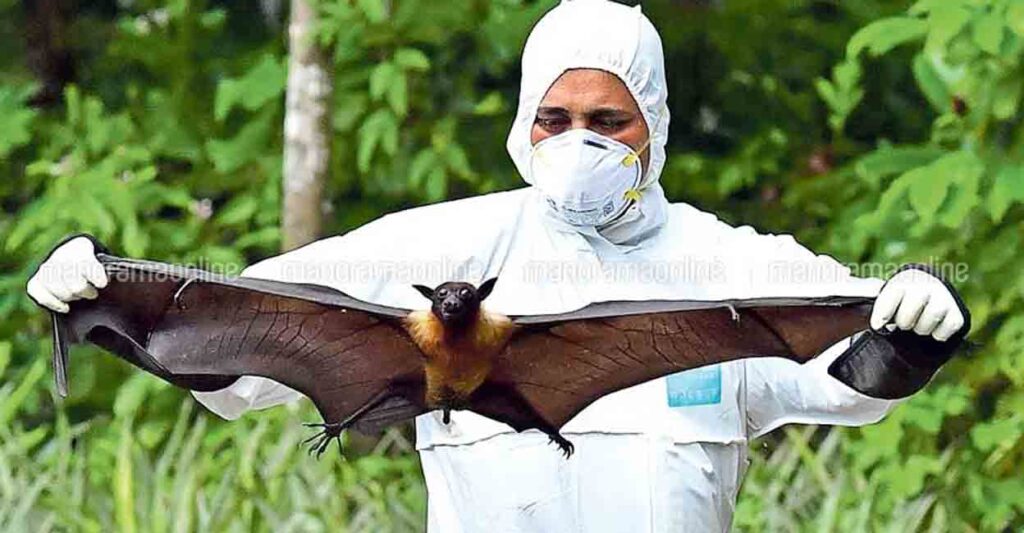Nipah virus (NiV) is a zoonotic disease that can infect humans when they come into contact with infected bats or pigs. This highly contagious virus poses a serious risk to the public’s health since it can transmit from person to person. The virus was first discovered during an outbreak in Malaysia, where sick pigs or their contaminated tissues were used to spread the disease to humans. Consumption of tainted fruits or fruit items, frequently with urine or saliva from sick fruit bats, was the likely cause of infection in later epidemics in Bangladesh and India.
Why Two Cases in Kerala Led to Alarms?

The health officials became concerned when two probable Nipah virus infections were discovered in Kerala. The Nipah virus was thought to have been present among those who perished in Kozhikode from “unnatural” causes. Due to the virus’s potentially serious consequences and the urgent need for containment measures, this led to a health alert.
Transmission of Nipah Virus
Nipah virus spread outbreaks have occurred in a number of nations. This dangerous pathogen can make people sick with severe respiratory and neurological conditions. To avoid and control this virus’s negative effects on public health, it is essential to understand how it spreads.
Fast or slow moving
Unlike influenza and COVID-19, which are both extremely contagious illnesses, the Nipah virus spreads slowly through the population. It displays a slower transmission rate that is influenced by particular transmission dynamics-related elements.
How Does It spread?
The main method of nipah virus transmission is direct contact with infected animals or their contaminated tissues. The main method of transmission during the original outbreak in Malaysia and Singapore was direct contact with infected pigs or their secretions. The ingestion of fruits or fruit items contaminated by the urine or saliva of infected fruit bats has emerged as the most likely cause of infection following subsequent outbreaks in Bangladesh and India.
There have also been cases of Nipah virus transmission between people, particularly between infected patients’ family members and caregivers. The virus can spread within communities and medical settings through close contact with an infected person’s fluids and excretions.
Fruit bats are the natural host
The Nipah virus spread’s natural hosts are fruit bats, notably those from the Pteropus genus. This makes the bats reservoirs for the virus because they don’t appear to be sick when they are infected. Henipaviruses share a lot of geographic space with Pteropus bats, and evidence of infection has been discovered in a number of places, including Australia, Bangladesh, Cambodia, China, India, Indonesia, Madagascar, Malaysia, Papua New Guinea, Thailand, and Timor-Leste.
Additionally, antibodies against the Nipah and Hendra viruses have been discovered in African fruit bats of the species Eidolon, which are also members of the Pteropodidae family, indicating that these viruses may be present in the regions where Pteropodidae bats are distributed.
Nipah virus in animals
Animals infected with the Nipah virus was discovered to infect not only pigs but also other domestic animals such horses, goats, sheep, cats, and dogs during the initial outbreak in Malaysia in 1999. Pigs, in particular, are particularly vulnerable and can spread the virus while it is incubating, even if they show no symptoms. Clinical symptoms in infected pigs can include neurological problems, fever, and difficulty breathing.
Although pig mortality is typically minimal, the virus can nevertheless be identified by its distinctive symptoms, such as a peculiar barking cough. Additionally, encephalitis cases in humans in locations where pigs are afflicted should prompt worries about Nipah virus spread.
Signs and Symptoms
Numerous signs of the Nipah virus infection can appear and range in severity. Fever, headaches, severe respiratory infections, muscle pain, and vomiting are typical symptoms. Additionally, some people may have neurological symptoms of acute encephalitis, such as a sore throat, disorientation, altered consciousness, and neurological symptoms. Typically, the incubation phase lasts 4 to 14 days.

Diagnosis
Laboratory testing to find the virus in a patient’s body are required for the diagnosis of Nipah virus infection. This frequently entails looking for genetic material or particular antibodies connected to the virus in blood or other bodily fluids. A prompt diagnosis is essential for effective treatment and containment measures.
Treatment
There are currently no antiviral medications specifically designed to treat Nipah virus infection. The cornerstone of treatment, supportive care concentrates on symptom management and offers medical aid as required. To stop further transmission, isolate patients who have Nipah virus infection, whether it is suspected or known.
Prevention
Transmission of the Nipah virus spread must be stopped at all costs. In order to lower their risk of infection, people should:
- Keep your distance from any contaminated people.
- Fruits and vegetables should be thoroughly washed before consumption.
- Avoid animals that might be infected with the virus.
- Avoid going to places where the Nipah virus has spread.
- Animal facilities may need to be quarantined during an outbreak, and diseased animals may need to be put down.
It’s crucial to disinfect hazardous places and machinery. It is advised that anyone exposed to potentially infected pigs utilize personal protective equipment (PPE), better biosecurity procedures, and education. Additionally, it is critical to take action to keep pig production facilities from coming into touch with bat reservoirs.
Research on the creation of Nipah virus vaccines is occurring in a number of nations, including Australia and France.
These safeguards and controls are essential for halting the Nipah virus’s transmission and averting additional outbreaks. The management of infection cases still requires early discovery, isolation, and appropriate medical care.
In conclusion, understanding the transmission dynamics of Nipah virus is critical for preventing and managing outbreaks. This virus can spread through various routes, from contact with infected animals to human-to-human transmission. With fruit bats as natural hosts and the potential for infection in domestic animals, vigilance and public health measures are essential to control the spread of this deadly virus.


1 thought on “Nipah Virus Spread”